Chapter 9: Working capital management – accounts receivable and payable
Chapter learning objectives
Upon completion of this chapter you will be able to:
- explain how to establish and implement a credit policy for accounts receivable
- explain the administration involved in collecting amounts owing from accounts receivable
- explain the pros and cons of offering early settlement discounts to accounts receivable
- calculate the financial implications of offering discounts for early settlement
- define and explain the features of factoring
- discuss the advantages and disadvantages of factoring
- define and explain the features of invoice discounting
- suggest and evaluate suitable techniques for managing accounts receivable within a scenario question
- explain the factors involved in the effective management of trade credit
- calculate the effective cost of an early settlement discount offered on an account payable
- discuss the advantages and disadvantages of trade credit as a source of short-term finance
- explain the specific factors to be considered when managing foreign accounts receivable and payable.
1 The objectives of accounts receivable management
The optimum level of trade credit extended represents a balance between two factors:
- profit improvement from sales obtained by allowing credit
- the cost of credit allowed.

 The balancing act
The balancing act
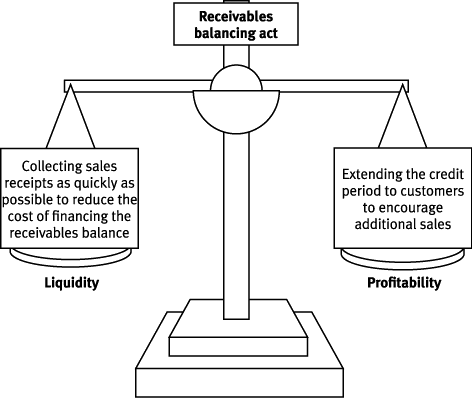
Remember this trade-off is a key factor in determining the company's working capital investment.

2 Accounts receivable – establishing a credit policy
Management must establish a credit policy.
 For accounts receivable, the company's policy will be influenced by:
For accounts receivable, the company's policy will be influenced by:
- demand for products
- competitors' terms
- risk of irrecoverable debts
- financing costs
- costs of credit control.

 Why have a credit policy?
Why have a credit policy?
A firm must establish a policy for credit terms given to itscustomers. Ideally the firm would want to obtain cash with each orderdelivered, but that is impossible unless substantial settlement (orcash) discounts are offered as an inducement. It must be recognised thatcredit terms are part of the firm's marketing policy. If the trade orindustry has adopted a common practice, then it is probably wise to keepin step with it.
A lenient credit policy may well attract additional customers, but at a disproportionate increase in cost.

A credit policy has four key aspects:
(1)Assess creditworthiness.
(2)Credit limits.
(3)Invoice promptly and collect overdue debts.
(4)Monitor the credit system.
 This is a useful structure to adopt for examination questions that ask about the management of receivables.
This is a useful structure to adopt for examination questions that ask about the management of receivables.
Assessing creditworthiness
A firm should assess the creditworthiness of:
- all new customers immediately
- existing customers periodically.
Information may come from:
- bank references
- trade references
- competitors
- published information
- credit reference agencies
- company sales records
- credit scoring.

 Assessing creditworthiness
Assessing creditworthiness
To minimise the risk of irrecoverable debts occurring, a companyshould investigate the creditworthiness of all new customers (creditrisk), and should review that of existing customers from time to time,especially if they request that their credit limit should be raised.Information about a customer's credit rating can be obtained from avariety of sources.
These include:
- Bank references – A customer's permission must be sought. These tend to be fairly standardised in the UK, and so are not perhaps as helpful as they could be.
- Trade references – Suppliers already giving credit to the customer can give useful information about how good the customer is at paying bills on time. There is a danger that the customer will only nominate those suppliers that are being paid on time.
- Competitors – in some industries such as insurance, competitors share information on customers, including creditworthiness.
- Published information – The customer's own annual accounts and reports will give some idea of the general financial position of the company and its liquidity.
- Credit reference agencies – Agencies such as Dunn & Bradstreet publish general financial details of many companies, together with a credit rating. They will also produce a special report on a company if requested. The information is provided for a fee.
- Company's own sales records – For an existing customer, the sales ledgers will show how prompt a payer the company is, although they cannot show the ability of the customer to pay.
- Credit scoring – Indicators such as family circumstances, home ownership, occupation and age can be used to predict likely creditworthiness. This is useful when extending credit to the public where little other information is available. A variety of software packages is available which can assist with credit scoring.

Credit limits
Credit limits should be set to reflect both the:
- amount of credit available
- length of time allowed before payment is due.
The ledger account should be monitored to take account of orders inthe pipeline as well as invoiced sales, before further credit is given.
Invoicing and collecting overdue debts
A credit period only begins once an invoice is received so promptinvoicing is essential. If debts go overdue, the risk of defaultincreases, therefore a system of follow-up procedures is required.

 Invoicing and collecting overdue debts
Invoicing and collecting overdue debts
The longer a debt is allowed to run, the higher the probability ofeventual default. A system of follow-up procedures is required, bearingin mind the risk of offending a valued customer to such an extent thattheir business is lost.
Techniques for 'chasing' overdue debts include the following:
- Reminder letters: these are often regarded as being a relatively poor way of obtaining payment, as many customers simply ignore them. Sending reminders by fax or email is usually more productive than using the post.
- Telephone calls: these are more expensive than reminder letters but where large sums are involved they can be an efficient way of speeding payment.
- Withholding supplies: putting customers on the 'stop list' for further orders or spare parts can encourage rapid settlement of debts.
- Debt collection agencies and trade associations: these offer debt collection services on a fixed fee basis or on 'no collection no charge' terms. The quality of service provided varies considerably and care should be taken in selecting an agent.
- Legal action: this is often seen as a last resort. A solicitor's letter often prompts payment and many cases do not go to court. Court action is usually not cost effective but it can discourage other customers from delaying payment.

Monitoring the system
The position of receivables should be regularly reviewed as part ofmanaging overall working capital and corrective action taken whenneeded. Methods include:
- age analysis
- ratios
- statistical data.

 Monitoring the system
Monitoring the system
Management will require regular information to take correctiveaction and to measure the impact of giving credit on working capitalinvestment. Typical management reports on the credit system will includethe following points.
- Age analysis of outstanding debts.
- Ratios, compared with the previous period or target, to indicate trends in credit levels and the incidence of overdue and irrecoverable debts.
- Statistical data to identify causes of default and the incidence of irrecoverable debts among different classes of customer and types of trade.

3 Accounts receivable – calculations
Costs of financing receivables
 Key working:
Key working:

 Test your understanding 1 – Cost of financing receivables
Test your understanding 1 – Cost of financing receivables
Paisley Co has sales of $20 million for the previous year,receivables at the year end were $4 million, and the cost of financingreceivables is covered by an overdraft at the interest rate of 12% pa.
Required:
(a)calculate the receivables days for Paisley
(b)calculate the annual cost of financing receivables.

Early settlement discounts
Cash discounts are given to encourage early payment by customers.The cost of the discount is balanced against the savings the companyreceives from having less capital tied up due to a lower receivablesbalance and a shorter average collection period. Discounts may alsoreduce the number of irrecoverable debts.
The calculation of the annual cost can be expressed as a formula:


Notice that the annual cost calculation is always based on the amount left to pay, i.e. the amount net of discount.
If the cost of offering the discount exceeds the rate of overdraft interest then the discount should not be offered.

 Test your understanding 2 – Early settlement discounts I
Test your understanding 2 – Early settlement discounts I
A company is offering a cash discount of 2.5% to receivables ifthey agree to pay debts within one month. The usual credit period takenis three months.
What is the effective annualised cost of offering the discount andshould it be offered, if the bank would loan the company at 18% pa?

The above calculation gives a quick and easy way to evaluate theannual cost and reach a decision on whether to offer an early settlementdiscount. This method should be used in all situations where allcustomers are expected to take advantage of the discount, or when thequestion does not specify the expected take up (as in test yourunderstanding 2).
However, in many scenarios, you may be provided with more in-depthinformation, in particular information relating to the proportion ofcustomers that are expected to take up the offer. In these situations itis necessary to perform a longer calculation.
The calculation involves comparing the cost of offering thediscount with the benefit that will be received (the lower financingcosts resulting from the reduced receivables balance)

 Test your understanding 3 – Early settlement discounts II
Test your understanding 3 – Early settlement discounts II
Paisley Co has sales of $20 million for the previous year,receivables at the year end of $4 million and the cost of financingreceivables is covered by an overdraft at the interest rate of 12% pa.It is now considering offering a cash discount of 2% for payment ofdebts within 10 days. Should it be introduced if 40% of customers willtake up the discount?

4 Accounts receivable – invoice discounting and factoring
Invoice discounting and factoring are both ways of speeding up the receipt of funds from accounts receivable.
Invoice discounting
 Invoice discounting is a method of raising finance against the securityof receivables without using the sales ledger administration servicesof a factor.
Invoice discounting is a method of raising finance against the securityof receivables without using the sales ledger administration servicesof a factor.
While specialist invoice discounting firms exist, this is a servicealso provided by a factoring company. Selected invoices are used assecurity against which the company may borrow funds. This is a temporarysource of finance, repayable when the debt is cleared. The keyadvantage of invoice discounting is that it is a confidential service,and the customer need not know about it.
In some ways it is similar to the financing part of the factoring service without control of credit passing to the factor.
 Ensure you can explain the difference between factoring and invoicediscounting, and the situations where one may be more appropriate thanthe other.
Ensure you can explain the difference between factoring and invoicediscounting, and the situations where one may be more appropriate thanthe other.

 Invoice discounting
Invoice discounting
Typical arrangement
Invoice discounting is a method of raising finance against thesecurity of receivables without using the sales ledger administrationservices of a factor. With invoice discounting, the business retainscontrol over its sales ledger, and confidentiality in its dealings withcustomers. Firms of factors will also provide invoice discounting toclients.
The method works as follows:
- The business sends out invoices, statements and reminders in the normal way, and collects the debts. With 'confidential invoice discounting', its customers are unaware that the business is using invoice discounting.
- The invoice discounter provides cash to the business for a proportion of the value of the invoice, as soon as it receives a copy of the invoice and agrees to discount it. The discounter will advance cash up to 80% of face value.
- When the business eventually collects the payment from its customer, the money must be paid into a bank account controlled by the invoice discounter. The invoice discounter then pays the business the remainder of the invoice, less interest and administration charges.
Invoice discounting can help a business that is trying to improveits cash flows, but does not want a factor to administer its salesledger and collect its debts. It is therefore equivalent to thefinancing service provided by a factor.
Administration charges for this service are around 0.5-1% of aclient's turnover. It is more risky than factoring since the clientretains control over its credit policy. Consequently, such facilitiesare usually confined to established companies with high sales revenue,and the business must be profitable. Finance costs are usually in therange 3–4% above base rate, although larger companies and those whicharrange credit insurance may receive better terms.
The invoice discounter will check the sales ledger of the clientregularly, perhaps every three months, to check that its debt collectionprocedures are adequate.


 Illustration of the invoice discounting process
Illustration of the invoice discounting process
At the beginning of August, Basildon plc sells goods for a totalvalue of $300,000 to regular customers but decides that it requirespayment earlier than the agreed 30-day credit period for these invoices.
A discounter agrees to finance 80% of their face value, i.e. $240,000, at an interest cost of 9% pa.
The invoices were due for payment in early September, but weresubsequently settled in mid-September, exactly 45 days after the initialtransactions. The invoice discounter's service charge is 1% of invoicevalue. A special account is set up with a bank, into which all paymentsare made.
The sequence of cash flows is:
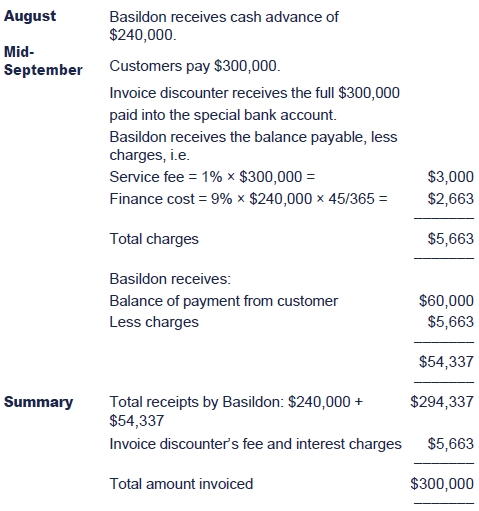

Factoring
 Factoring is the outsourcing of the credit control department to a third party.
Factoring is the outsourcing of the credit control department to a third party.
The debts of the company are effectively sold to a factor (normallyowned by a bank). The factor takes on the responsibility of collectingthe debt for a fee. The company can choose some or all of the followingthree services offered by the factor:
(1)debt collection and administration – recourse or non-recourse
(2)financing
(3)credit insurance.
 These are of particular value to:
These are of particular value to:
- smaller firms
- fast growing firms.
Make sure you can discuss the various services offered and rememberthat non-recourse factoring is more expensive as the factor bears thecosts of any irrecoverable debts.

 Factoring
Factoring
Debt collection and administration – the factor takes over thewhole of the company's sales ledger, issuing invoices and collectingdebts.
Financing provision – in addition to the above, the factor willadvance up to 80% of the value of a debt to the company; the remainder(minus finance costs) being paid when the debts are collected. Thefactor becomes a source of finance. Finance costs are usually 1.5% to 3%above bank base rate and charged on a daily basis.
Credit insurance – the factor agrees to insure the irrecoverabledebts of the client. The factor would then determine to whom the companywas able to offer credit.
Some companies realise that, although it is necessary to extendtrade credit to customers for competitive reasons, they need paymentearlier than agreed in order to assist their own cash flow. Factorsexist to help such companies.
Factoring is most suitable for:
- small and medium-sized firms which often cannot afford sophisticated credit and sales accounting systems, and
- firms that are expanding rapidly. These often have a substantial and growing investment in inventory and receivables, which can be turned into cash by factoring the debts. Factoring debts can be a more flexible source of financing working capital than an overdraft or bank loan.
Factoring is primarily designed to allow companies to acceleratecash flow, providing finance against outstanding trade receivables. Thisimproves cash flow and liquidity.
Factoring can be arranged on either a 'without recourse' basis or a 'with recourse' basis.
- When factoring is without recourse or 'non-recourse', the factor provides protection for the client against irrecoverable debts. The factor has no 'comeback' or recourse to the client if a customer defaults. When a customer of the client fails to pay a debt, the factor bears the loss and the client receives the money from the debt.
- When the service is with recourse ('recourse factoring'), the client must bear the loss from any irrecoverable debt, and so has to reimburse the factor for any money it has already received for the debt.
Credit protection is provided only when the service is non-recourse and this is obviously more costly.
Typical factoring arrangements
Administration and debt collection
Including financing

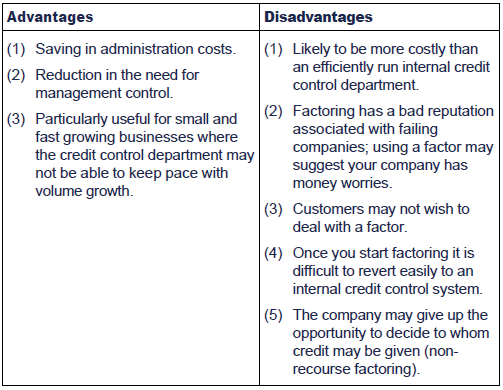

 Benefits and problems with factoring
Benefits and problems with factoring
The benefits of factoring are as follows.
- A business improves its cash flow, because the factor provides finance for up to 80% or more of debts within 24 hours of the invoices being issued. A bank providing an overdraft facility secured against a company's unpaid invoices will normally only lend up to 50% of the invoice value. (Factors will provide 80% or so because they set credit limits and are responsible for collecting the debts.)
- A factor saves the company the administration costs of keeping the sales ledger up to date and the costs of debt collection.
- A business can use the factor's credit control system to assess the creditworthiness of both new and existing customers.
- Non-recourse factoring is a convenient way of obtaining insurance against irrecoverable debts.
Problems with factoring.
- Although factors provide valuable services, companies are sometimes wary about using them. A possible problem with factoring is that the intervention of the factor between the factor's client and the debtor company could endanger trading relationships and damage goodwill. Customers might prefer to deal with the business, not a factor.
- When a non-recourse factoring service is used, the client loses control over decisions about granting credit to its customers.
- For this reason, some clients prefer to retain the risk of irrecoverable debts, and opt for a 'with recourse' factoring service. With this type of service, the client and not the factor decides whether extreme action (legal action) should be taken against a non-payer.
- On top of this, when suppliers and customers of the client find out that the client is using a factor to collect debts, it may arouse fears that the company is beset by cash flow problems, raising fears about its viability. If so, its suppliers may impose more stringent payment terms, thus negating the benefits provided by the factor.
- Using a factor can create problems with customers who may resent being chased for payment by a third party, and may question the supplier's financial stability.


 Test your understanding 4 – Factoring arrangements
Test your understanding 4 – Factoring arrangements
Edden is a medium-sized company producing a range of engineeringproducts, which it sells to wholesale distributors. Recently, its saleshave begun to rise rapidly due to economic recovery. However, it isconcerned about its liquidity position and is looking at ways ofimproving cash flow.
Its sales are $16 million pa, and average receivables are $3.3 million (representing about 75 days of sales).
One way of speeding up collection from receivables is to use a factor.
Required:
Determine the relative costs and benefits of using the factor in each of the following scenarios.
(a)The factor will operate on aservice-only basis, administering and collecting payment from Edden’scustomers. This is expected to generate administrative savings of$100,000 each year.
The factor has undertaken to pay outstanding debts after 45 days,regardless of whether the customers have actually paid or not. Thefactor will make a service charge of 1.75% of Edden’s turnover. Eddencan borrow at an interest rate of 8% pa.
(b)It is now considering afactoring arrangement with a different factor where 80% of the bookvalue of invoices is paid immediately, with finance costs charged on theadvance at 10% pa.
Suppose that this factor will charge 1% of sales as their fee formanaging the sales ledger, that there will be administrative savings of$100,000 as before, but that outstanding balances will be paid after 75days (i.e. there is no change in the typical payment pattern bycustomers this time).

5 Accounts payable – managing trade credit
Trade credit is the simplest and most important source of short-term finance for many companies.
Again it is a balancing act between liquidity and profitability.

 The balancing act
The balancing act
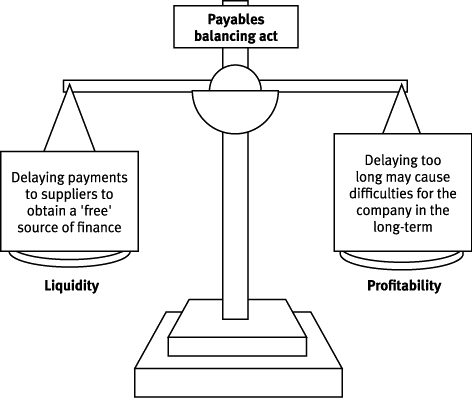

By delaying payment to suppliers companies face possible problems:
- supplier may refuse to supply in future
- supplier may only supply on a cash basis
- there may be loss of reputation
- supplier may increase price in future.
Trade credit is normally seen as a 'free' source of finance. Whilstthis is normally true, it may be that the supplier offers a discountfor early payment. In this case delaying payment is no longer free,since the cost will be the lost discount.
 In the examination, you need to be able to calculate the cost of this discount foregone.
In the examination, you need to be able to calculate the cost of this discount foregone.
It can be done using the same techniques we saw under accounts receivable.

 Test your understanding 5 – Discount for early payment
Test your understanding 5 – Discount for early payment
One supplier has offered a discount to Box Co of 2% on an invoicefor $7,500, if payment is made within one month, rather than the threemonths normally taken to pay. If Box's overdraft rate is 10% pa, is itfinancially worthwhile for them to accept the discount and pay early?


 Test your understanding 6 – Equivalent annual cost of discount
Test your understanding 6 – Equivalent annual cost of discount
Work out the equivalent annual cost of the following credit terms:1.75% discount for payment within three weeks; alternatively, fullpayment must be made within eight weeks of the invoice date. Assumethere are 50 weeks in a year.
Hint: Consider a $100 invoice.


 Trade payables
Trade payables
Under trade credit a firm is able to obtain goods (orservices) from a supplier without immediate payment, the supplieraccepting that the firm will pay at a later date.
Trade credit periods vary from industry to industry and eachindustry will have what is a generally accepted norm which would be fromseven days upwards. The usual terms of credit range from four weeks tothe period between the date of purchase and the end of the monthfollowing the month of purchase.
However, considerable scope for flexibility exists and longercredit periods are sometimes offered, particularly where the type ofbusiness activity requires a long period to convert materials intosaleable products, e.g. farming.
A proportion of the firm's suppliers will normally offer early settlement discountswhich should be taken up where possible by ensuring prompt paymentwithin the specified terms where settlement discount is allowed.However, if the firm is short of funds, it might wish to make maximumuse of the credit period allowed by suppliers regardless of thesettlement discounts offered.
It is a mistake to reduce working capital by holding on tocreditors' money for a longer period than is allowed as, in thelong-term, this will affect the supplier's willingness to supply goodsand raw materials, and cause further embarrassment to the firm.
Favourable credit terms are one of several factors which influencethe choice of a supplier. Furthermore, the act of accepting settlementdiscounts has an opportunity cost, i.e. the cost of finance obtainedfrom another source to replace that not obtained from creditors.
Whilst trade credit may be seen as a source of free credit , there will be costsassociated with extending credit taken beyond the norm – lostdiscounts, loss of supplier goodwill, more stringent terms for futuresales.
In order to compare the cost of different sources of finance, allcosts are usually converted to a rate per annum basis. The cost ofextended trade credit is usually measured by loss of discount, but thecalculation of its cost is complicated by such variables as the numberof alternative sources of supply, and the general economic conditions.
Certain assumptions have to be made concerning (a) the maximumdelay in payment which can be achieved before the supply of goods iswithdrawn by the supplier, and (b) the availability of alternativesources of supply.

6 Accounts receivable and payable – managing foreign trade
Overseas accounts receivable and payable bring additional risks that need to be managed:
 Export credit risk is the risk of failure or delay in collecting payments due from foreign customers.
Export credit risk is the risk of failure or delay in collecting payments due from foreign customers.
 Foreign exchange risk is the risk that the value of thecurrency will change between the date of contract and the date ofsettlement. For more details see chapter 11.
Foreign exchange risk is the risk that the value of thecurrency will change between the date of contract and the date ofsettlement. For more details see chapter 11.

 Risks of overseas trades
Risks of overseas trades
Whilst all of the basic management principles and techniquesdiscussed so far apply equally to overseas receivables and payables,there are additional risks that will need to be managed, including:
- export credit risk; and
- foreign exchange transaction exposure.
Possible causes of loss from export credit risk, which apply to all export trade of whatever size, include the following.
- Illiquidity or insolvency of the customer. This also occurs in domestic trading. When an export customer cannot pay however, suppliers have extra problems in protecting their positions in a foreign legal and banking system.
- Bankruptcy or failure of a bank in the remittance chain.
- A poorly-specified remittance channel.
- Inconvertibility of the customer's currency, and lack of access to the currency in which payment is due. This can be caused by deliberate exchange controls or by an unplanned lack of foreign exchange in the customer's central bank.
- Political risks. Their causes can be internal (change of regime, civil war) or external (war, blockade) to the country concerned.
Exporters can protect themselves against these risks by the following means.
- Use banks in both countries to act as the collecting channel for the remittance and to control the shipping documents so that they are only released against payment or acceptance of negotiable instruments (bills of exchange or promissory notes).
- Commit the customer's bank through an international letter of credit (ILC).
- Require the ILC to be confirmed (effectively guaranteed) by a first class bank in the exporter's country. This makes the ILC a confirmed ILC (CILC).
- Obtain support from third parties, e.g.:
- get a guarantee of payment from a local bank
- get a letter from the local finance ministry or central bank confirming availability of foreign currency.
- Take out export credit cover.
- Use an intermediary such as a confirming, export finance, factoring or forfeiting house to handle the problems on their behalf; or possibly by giving no credit or selling only through agents who accept the credit risk (del credere agents) and are themselves financially strong.
None of these devices will enable the exporter to escape from certain hard facts of life.
- The need to avoid giving credit to uncreditworthy customers. Weak customers cannot obtain an ILC from their own bank, nor would they be cleared for credit by a credit insurer or intermediary.
- The need to negotiate secure payment terms, procedures and mechanisms which customers do not find congenial. An ILC and especially a CILC are costly to customers, and restrict their flexibility: if they are short of cash at the end of the month, they must still pay out if their bank is committed.
- Exporters can only collect under a letter of credit if they present exactly the required documents. They will not be able to do this if they have sent the goods by air and the credit requires shipping documents; or if they need to produce the customer's inspection certificates and the customer's engineer is mysteriously unavailable to inspect or sign.
- The need to insist that payment is in a convertible currency and in a form which the customer's authorities will permit to become effective as a remittance to where the exporters need to have the funds, usually in their own country. Often this means making the sale subject to clearance under exchange controls or import licensing regulations.
Introductory points about foreign exchange:
Many companies trade in foreign currencies, either buying fromabroad in a foreign currency or denominating sales to export customersin a foreign currency.
If so they might need to:
- buy foreign currency to pay a supplier, or
- convert foreign currency receipts into domestic currency.
Like domestic trade, foreign trade is arranged on credit terms.Companies usually know in advance what foreign currency they will needto pay out and what currencies they will be receiving. Foreign exchangerisk arises in these situations:
- If a company has to obtain foreign currency at a future date to make a payment there is a risk that the cost of buying the currency will rise (from what it would cost now) if the exchange rate moves and the currency strengthens in value.
- If a company will want to convert currency earnings into a domestic currency at a future date, there is a risk that the value of the currency will fall (from its current value) if the exchange rate moves and the currency falls in value.
Exposures to these risks of adverse changes in an exchange rate areknown as 'foreign exchange transaction exposures'. These exposures canbe 'hedged' (reduced or offset). The methods available to hedge therisks are covered in chapter 11.
In a question that deals with overseas receivables and payablesremember to consider export credit risk and foreign transaction exposureas well as the normal points on the management of receivables andpayables.

Chapter summary
Test your understanding answers

 Test your understanding 1 – Cost of financing receivables
Test your understanding 1 – Cost of financing receivables
Solution
(a)Receivables days = $4m ÷ $20m × 365 = 73 days
(b)Cost of financing receivables = $4m × 12% = $480,000.


 Test your understanding 2 – Early settlement discounts I
Test your understanding 2 – Early settlement discounts I
Discount as a percentage of amount paid = 2.5/97.5 = 2.56%
Saving is 2 months and there are 12/2 = periods in a year.
Annualised cost of discount % is
(1+0.0256)6 –1 = 0.1638 = 16.38%.
The loan rate is 18%.
It would therefore be worthwhile offering the discount.


 Test your understanding 3 – Early settlement discounts II
Test your understanding 3 – Early settlement discounts II
To determine if the early settlement discount should be introduced, a comparison must be made between the cost and the benefit.
Cost
$20m of revenue × 40% take up × 2% discount = $160,000
Benefit
The benefit is a reduction in the receivables balance which willresult in a higher cash balance, thereby reducing interest payable (say,on an overdraft balance). The value can be found by:
(1)Calculate the current level of receivables & receivables days
(2)Calculate the cost of financing this
(3)Calculate the new level of receivables & receivables days
(4)Calculate the cost of financing this new level
(5)Compare the old cost with the new cost to determine the benefit
Step 1 – Calculate the current level of receivables & receivables days
The current receivables balance is $4m (per the question). This implies receivables days of:
$4m / $20m × 365 = 73 days
Step 2 – Calculate the cost of financing this
$4m × 12% interest = $480,000 p.a
Step 3 – Calculate the new level of receivables & receivables days
Since 40% of customers will now pay within 10 days, and theremaining 60% will continue paying as before (i.e. taking 73 days), thenew level of receivables can be assumed to be:
10/365 × $20m × 40% =$219,178
73/365 × $20m × 60% = $2,400,000
Total $2,619,178
Step 4 – Calculate the cost of financing this new level
$2,619,178 × 12% interest = $314,301
Step 5 – Compare the old cost with the new cost to determine the benefit
The benefit of the lower receivables balance is therefore $480,000 – $314,301 = $165,699.
Comparison of cost and benefit
Now we can compare the cost of offering the discount with the benefit.
Cost = $160,000
Benefit = $165,699
Net benefit = $5,699
The conclusion is that this discount should be offered.


 Test your understanding 4 – Factoring arrangements
Test your understanding 4 – Factoring arrangements
(a)Reduction in receivables days = 75 - 45 = 30 days
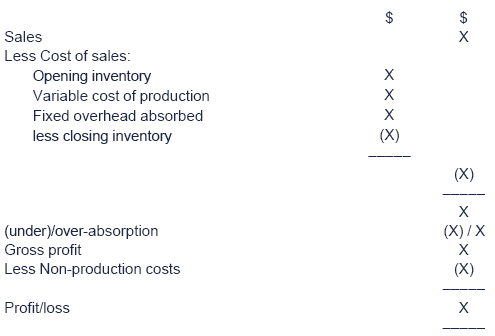
Edden will have to balance this cost against the security offered by improved cash flows and greater liquidity.
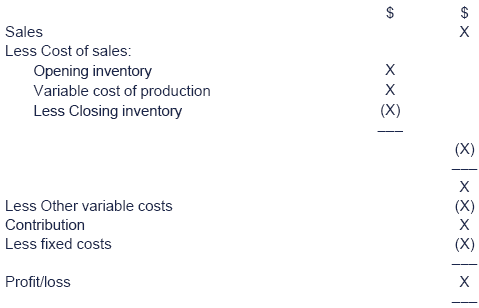
As before the firm will have to balance this cost against the security offered by improved cash flows and greater liquidity.


 Test your understanding 5 – Discount for early payment
Test your understanding 5 – Discount for early payment
Discount saves 2% of $7,500 =$150
Financed by overdraft for extra two months in order to pay early:

It is worth accepting the discount.
Alternatively :

The overdraft rate is 10%.
It would be cheaper to borrow the money from the bank to pay early and accept the discount.


 Test your understanding 6 – Equivalent annual cost of discount
Test your understanding 6 – Equivalent annual cost of discount
Step 1
Work out the discount available and the amount due if the discount were taken.
Discount available on a $100 invoice = 1.75% × $100 = $1.75.
Amount due after discount = $100 × $1.75 = $98.25
Step 2
The effective interest cost of not taking the discount is:
1.75 ÷ 98.25 = 0.0178
for an 8 – 3 = five-week period.
Step 3
Calculate the equivalent annual rate. There are ten five-week periods in a year.
The equivalent interest annual rate is (1 + 0.018)10 – 1 = 0.195 or 19.5%.

|
Created at 5/24/2012 4:15 PM by System Account
(GMT) Greenwich Mean Time : Dublin, Edinburgh, Lisbon, London
|
Last modified at 5/25/2012 12:54 PM by System Account
(GMT) Greenwich Mean Time : Dublin, Edinburgh, Lisbon, London
|
|
|
|
 |
Rating
:
|
 Ratings & Comments
(Click the stars to rate the page) Ratings & Comments
(Click the stars to rate the page)
|
 |
Tags:
|
|
|
|
|